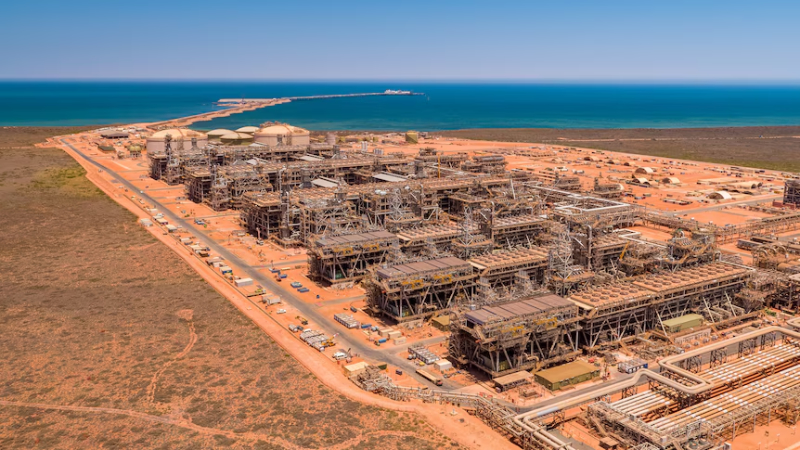Australia’s best-known Carbon Capture & Storage plant captures a mere fraction of the total emissions it generates. David McEwen explains.
Carbon Capture and Storage (CCS) is supposed to be the solution to permit high-emissions fossil fuels, with fossil fuel firms having claimed for decades that it allows uninterrupted use of their product. Governments around the world have fallen for it, contributing at least US$30B in subsidies, including over $1.3B by Australian governments.
However, it’s been well documented that despite this investment (and the associated private spend), the amount of carbon sequestered globally is still trivial – equivalent to less than three Australian coal-fired power stations.
Despite this, Santos recently hailed “growing recognition of carbon capture and storage potential” based on a report from EY. It’s clear that they’re not giving up on the con just yet.
And Gorgon, Chevron’s ‘flagship’ CCS project in Western Australia, captures as little as 1% of the emissions it produces.
Carbon Captured: Santos emails reveal gas giant orchestrated “Environment Protection” laws
CCS methods explained
The storage bit of CCS generally involves either injecting carbon dioxide deep underground (geological storage), converting it to an inert solid (mineralisation) and/or using captured carbon dioxide in fuels, plastics or chemicals (which may just kick the emissions can down the road to the product’s end of life).
Despite the publicity, many people are still sketchy on the details, including that there are several different types of carbon capture that achieve different objectives. Broadly, they can be classified as follows:
Post-combustion, which involves retrofitting a factory or coal/gas power station to capture the carbon dioxide, also known as ‘point source capture’. There are currently no commercial-scale post-combustion CCS plants operating in Australia. It’s expensive and energy-intensive.
Direct Air Capture (DAC) extracts carbon dioxide directly from ambient air using a chemical process and energy. The largest such plant, in Iceland, was recently found to be emitting more than it captures. Again, nothing is operating at any useful scale in Australia (or, indeed, in the world).
Wellhead CCS exists because many underground methane (aka “natural” or fossil gas) reservoirs have a fair proportion of carbon dioxide mixed in them. Both carbon dioxide and methane are greenhouse gases, but when it comes to gas drilling, methane is the product, while carbon dioxide is the unwanted by-product.
So, instead of venting the carbon dioxide into the atmosphere, wellhead CCS tries to capture and bury (sequester) it in a stable geological formation.
The only commercial-scale plants in Australia – Chevron’s troubled Gorgon plant, and Santos’ Moomba plant – are Wellhead CCS, which is the focus of the rest of this article.
An issue of fractions
Wellhead CCS suffers from what I call the “fraction of a fraction of a fraction” problem.
Fraction 1 is the percentage of carbon dioxide mixed in with the methane that you can actually capture.
Fraction 2 is the percentage of “well to factory” or “well to building” supply chain emissions, often emitted as methane, which is about 85 times more potent as a greenhouse gas than carbon dioxide. That is to say, a kilogram of methane does the warming work of 85 kilograms of carbon dioxide over a 20-year period when they’re released into the atmosphere. These supply chain emissions include:
-
- At the wellhead, emissions are produced by venting and flaring methane.
- Methane gas pipelines leak on the way to processing plants.
- The processing plants use massive amounts of gas to compress (liquify) the gas and put it on a ship – about 10% of what is exported as LNG is used for processing.
- Some of the LNG (liquid methane) may evaporate while on the ship.
- At the import terminal, there are more losses associated with converting LNG back to gas and getting it into a distribution pipeline (which leaks and may require energy for pumps).
Eventually, the gas gets to the machine or appliance in which it is used, which leads to:
Fraction 3, the emissions associated with the combustion of methane gas in a factory or building. When methane gas (or coal, or wood for that matter) is burnt, the carbon in the fuel combines with oxygen in the air to form carbon dioxide (while the hydrogen atoms in the fuel also combine with oxygen in the air to form water vapour).
Also, there’s often venting of uncombusted methane. For example, an instantaneous (tankless) gas hot water unit releases a puff of methane – before the spark ignites the gas – every time someone turns on the hot tap, even if it’s just for a second. That adds up to about 1% of the gas used at the appliance being released uncombusted as methane.
CCS example
Chevron’s Gorgon gas field is about 14% carbon dioxide, the rest is methane. In 2023-24, the CCS plant managed to capture about 30% of the carbon dioxide.
Burning 1 kg of methane releases 2.75 kg of carbon dioxide (it’s more than the weight of the fuel because the oxygen atoms – the “dioxide” – come from the atmosphere).
We don’t precisely know the methane emissions from venting, leaks, evaporation and other supply chain factors because it’s not properly estimated, but it’s unlikely to be lower than 3% of the methane based on this US data. That gets multiplied by 85 to equate it to the equivalent amount of carbon dioxide. (Chevron reported 8.8 million tonnes of emissions at the Gorgon plant in 2023-24, making it alone responsible for around 2% of Australia’s total emissions!)
Returning to our fractions, first, for every 100 kilograms of gas coming out of the Gorgon reservoir, 14kg is carbon dioxide, and 86kg is methane.
Then, fraction 2, the 3% of 86 kg of actual methane is 2.6 kg lost across the supply chain, leaving 83.4kg that is combusted (fraction 3).
The 2.6 kg of methane is multiplied by 85 (see above) to give 223.6 kg of carbon dioxide equivalent.
In summary, for each 100kg of gas coming out of Gorgon,
- 4.2kg is captured (30% of the 14kg carbon dioxide)
- 9.8kg is not captured
- 223.6 kg carbon dioxide equivalent from supply chain methane losses
- 229.35 kg of carbon dioxide from the combustion of the methane
That’s a total of 462.75 kg of unabated carbon dioxide equivalent “well to factory” or “well to building” emissions for every 100kg coming out of the Gorgon well.
All that has been captured and stored is 4.2 kg, a mere 0.9%!
A subsidised con
The Australian government committed $60m to Chevron’s CCS plant, with the overall costs of the CCS plant estimated at $3.5B. Given the amount of press releases about it from the Australian and WA governments, not to mention Chevron and their industry boosters, you’d be forgiven for expecting it to be capturing and storing perhaps a teensy bit more than 0.9% of the plant’s total supply chain emissions.
Now, I’m sure there will be people wanting to argue about the maths and the assumptions used,1 but I doubt even the most favourable analysis could lift the figure beyond the mid single digits.
Wellhead CCS – the only commercial-scale CCS in Australia – is a dead-end, fraction of a fraction of a fraction proposition.
Note 1:
In the absence of an accurate measurement of the supply chain methane losses, an estimate of 3% has been applied. This analysis also uses the 20-year “global warming potential” (GWP) number of 85 for methane, which reflects the fact that methane does most of its climate damage within 20 years of emission to the atmosphere. If the more conventional 100 year GWP of 28 is used and an optimistic 1% loss rate applied, the “Fraction 2” figure becomes 24.1 kg of carbon dioxide equivalent. This changes the percentage that Gorgon’s CCS plant is capturing to under 1.6%. Still pretty trivial in the scheme of things.
Of course, some might point out that the “Fraction 3” combustion emissions happen overseas for exported gas and therefore aren’t Chevron’s or Australia’s problem. But that’s equivalent to saying that a dam burst on the Chinese section of the Mekong River wouldn’t affect downstream countries such as Vietnam.
David McEwen is a Director at Adaptive Capability, providing climate risk and emissions reduction strategy, program and project management. He works with businesses, community leaders, policy makers, designers and engineers to deliver impactful change. His book, Navigating the Adaptive Economy, was released in 2016. He holds an MBA from the Australian Graduate School of Management and a certificate in Sustainability and Climate Risk from the Global Association of Risk Professionals.

